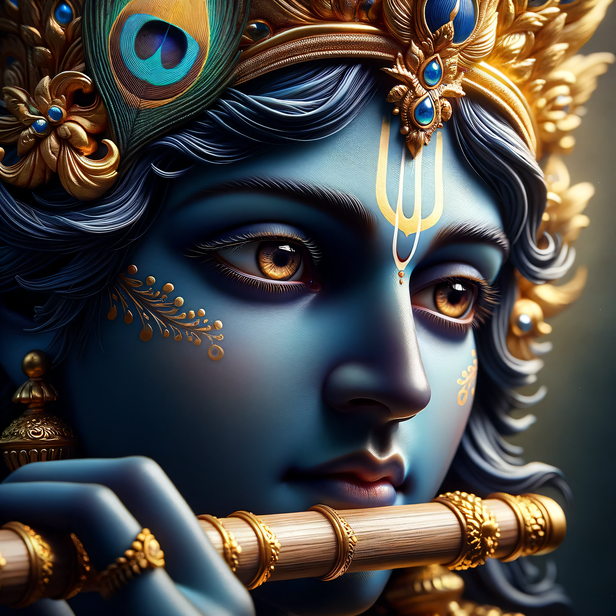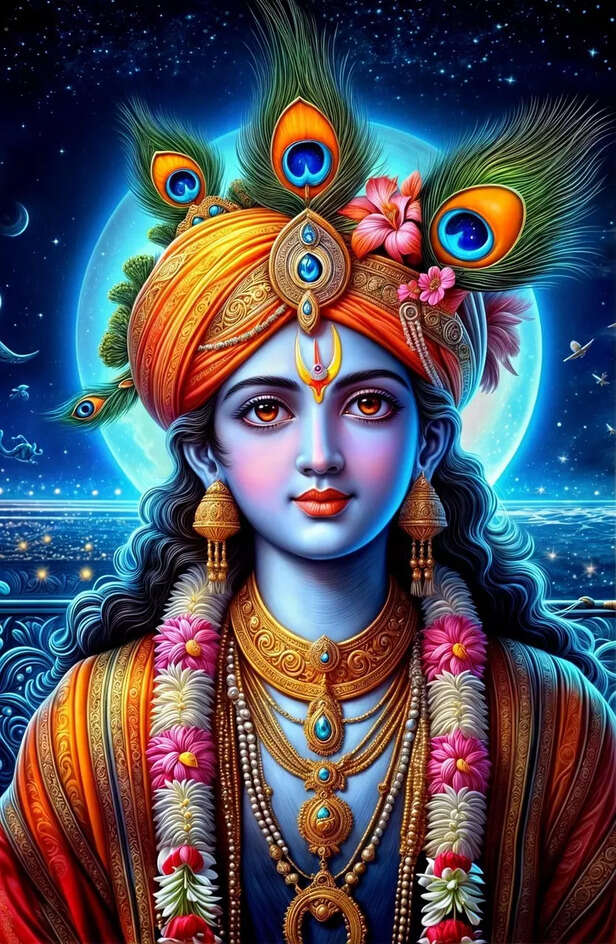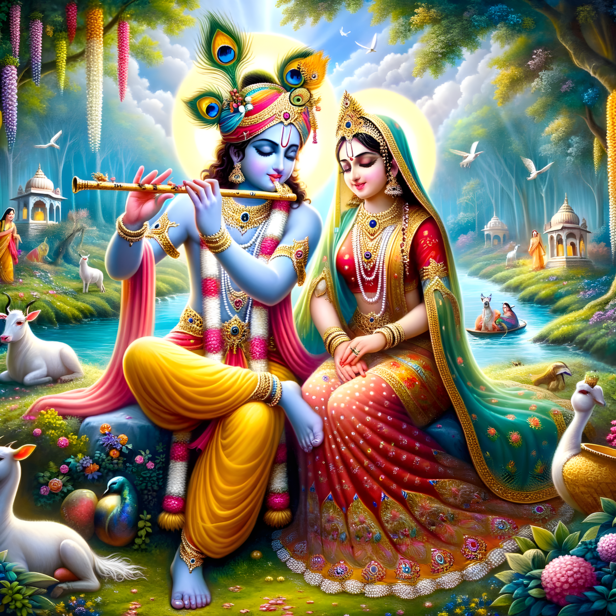Why Krishna’s Skin Appears Blue And Why Is He Called Shyama
Riya Kumari | Sep 01, 2025, 23:57 IST
Krishna
( Image credit : AI )
Krishna’s depiction in deep blue or dark complexion is not mere aesthetics, it’s a metaphor steeped in sacred symbolism. In scriptures and spiritual discourses, blue stands for the infinite, the immeasurable, the all-encompassing. Temples and Puranic art use this symbolism to subtly teach: the divine is boundless, serene, eternal. The vast sky and ocean, blue in essence, mirror Krishna’s cosmic magnitude
When we look at an image of Krishna, his form painted in deep blue or dark hues, it is easy to see it as an artistic choice. But in Hindu thought, nothing sacred is without meaning. Krishna’s blue complexion is not mere decoration. It is a symbol, a teaching, and an invitation to reflect on life and divinity itself.

In scriptures and spiritual discourses, blue stands for the vast, the immeasurable, the infinite. Swami Chinmayananda once explained: “Whatever is immeasurable can appear to the mortal eye only as blue, just like the cloudless sky.”
When we look at the sky or the ocean, what do we see? No boundaries. No beginning or end. Only depth, only vastness. Krishna embodies that same boundlessness. His blueness is a reminder that divinity cannot be confined or measured, it stretches beyond the grasp of the human mind.

Scriptures describe Krishna’s complexion with the word shyama. It does not mean black in the way we think of color today. It means something deeper, a shade that holds all hues within it, a union of every color and meaning.
The Srimad-Bhagavatam describes him as “nilotpala-dala-shyama, like the delicate blue lotus. The Brahma samhita speaks of him as being like “clouds heavy with rain.” These are not simply poetic lines. They are metaphors that help the human mind imagine that which is beyond imagination.

Some teachers suggest Krishna’s blue was never about skin at all. Sadhguru, for instance, says blue represents all-inclusiveness, a vastness beyond perception. In this sense, Krishna’s color is more of an aura than a complexion, a glow that the pure-hearted could perceive.
In many traditions, a blue aura is seen as the sign of spiritual illumination. If Krishna is shown as blue, it is because he carried within him the boundless presence of the divine. It is not something you only see. It is something you feel.

And yet, Krishna was not distant or untouchable. He lived as a son, a friend, a guide, a teacher. He played, laughed, and even endured trials. Some stories say that as a child, when he killed the demoness Putana who had smeared poison on her body, the poison gave his skin a bluish tinge.
Whether taken literally or symbolically, it reveals the same truth, Krishna transforms even poison into beauty, even adversity into strength. This is why Krishna remains so approachable. He is vast like the sky, yet close like a friend.

Artists across centuries and regions have painted Krishna in shades ranging from gentle sky-blue to deep midnight. Each color choice reflects the resources of the artist, the culture of the region, and the devotional lens through which he was seen. But none deviate from the truth: Krishna’s form must evoke the infinite.
Even in cinema and popular art, his blue complexion is preserved. Because for devotees, the color itself is sacred, it is not paint on skin, but a window into his mystery.
When we see Krishna’s blue form, let us pause. It is a mirror for our own lives.
When you next see his form, whether in a temple, a painting, or in your imagination, let it be a reminder: the infinite is never far. It is already here, waiting to be seen.
The Infinite in Blue

Blue
( Image credit : Unsplash )
In scriptures and spiritual discourses, blue stands for the vast, the immeasurable, the infinite. Swami Chinmayananda once explained: “Whatever is immeasurable can appear to the mortal eye only as blue, just like the cloudless sky.”
When we look at the sky or the ocean, what do we see? No boundaries. No beginning or end. Only depth, only vastness. Krishna embodies that same boundlessness. His blueness is a reminder that divinity cannot be confined or measured, it stretches beyond the grasp of the human mind.
Shyama: The Color Beyond Color

Krishna
( Image credit : Pixabay )
Scriptures describe Krishna’s complexion with the word shyama. It does not mean black in the way we think of color today. It means something deeper, a shade that holds all hues within it, a union of every color and meaning.
The Srimad-Bhagavatam describes him as “nilotpala-dala-shyama, like the delicate blue lotus. The Brahma samhita speaks of him as being like “clouds heavy with rain.” These are not simply poetic lines. They are metaphors that help the human mind imagine that which is beyond imagination.
More Than Skin: Aura and Presence

Shri Krishna
( Image credit : Pixabay )
Some teachers suggest Krishna’s blue was never about skin at all. Sadhguru, for instance, says blue represents all-inclusiveness, a vastness beyond perception. In this sense, Krishna’s color is more of an aura than a complexion, a glow that the pure-hearted could perceive.
In many traditions, a blue aura is seen as the sign of spiritual illumination. If Krishna is shown as blue, it is because he carried within him the boundless presence of the divine. It is not something you only see. It is something you feel.
Human Yet Divine

Radha Krishna
( Image credit : Pixabay )
And yet, Krishna was not distant or untouchable. He lived as a son, a friend, a guide, a teacher. He played, laughed, and even endured trials. Some stories say that as a child, when he killed the demoness Putana who had smeared poison on her body, the poison gave his skin a bluish tinge.
Whether taken literally or symbolically, it reveals the same truth, Krishna transforms even poison into beauty, even adversity into strength. This is why Krishna remains so approachable. He is vast like the sky, yet close like a friend.
Art, Culture, and Devotion

Lord krishna
( Image credit : Pixabay )
Artists across centuries and regions have painted Krishna in shades ranging from gentle sky-blue to deep midnight. Each color choice reflects the resources of the artist, the culture of the region, and the devotional lens through which he was seen. But none deviate from the truth: Krishna’s form must evoke the infinite.
Even in cinema and popular art, his blue complexion is preserved. Because for devotees, the color itself is sacred, it is not paint on skin, but a window into his mystery.
A Reflection to Carry
- Just as the sky has no boundary, we too are called to think beyond our limitations.
- Just as the ocean holds storms and still returns to calm, we too can learn to carry serenity within turbulence.
- Just as Krishna’s color holds all hues, life too is a unity of joy and sorrow, light and dark, all woven together.
When you next see his form, whether in a temple, a painting, or in your imagination, let it be a reminder: the infinite is never far. It is already here, waiting to be seen.
